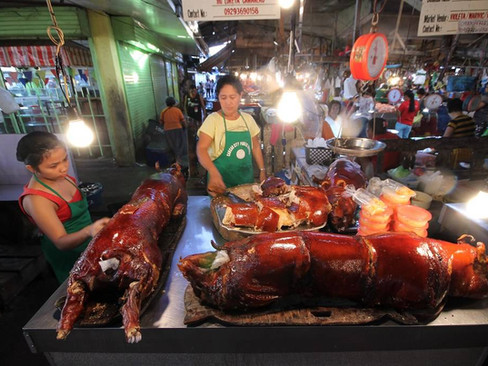THE PHILIPPINES FOOD GUIDE
Filipino cuisine has developed from the many different cultures that have helped shape the Philippines history. It has created a wonderful melange of Indian, Chinese, Malay, Spanish, European and American influences.
Its cuisine may not be as renowned as many of its neighbours, but Filipino cooking is distinct in that it is possibly the least spicy of all Southeast Asian cuisines! Don't make the mistake of thinking that Filipino food is bland, though - instead of spices, Filipino food tends to depend more on garlic, onions and ginger to add flavour to their dishes. Vegetarians and vegans might have a tough time finding a Filipino dish which is wholly vegetarian as most of the Filipinos love to add meat to every single dish they eat.
RELATED POSTS:
ADOBO
This is without a doubt the national dish of the Philippines. It consists of chicken or pork (or both), served in a garlicky stew with vinegar and soy sauce as a base. The best adobo has a perfect balance of soy sauce, and vinegar with added flavour from garlic, bay leaves and freshly ground peppercorns. We loved the richness of Filipino pork adobo and had many delicious servings during our 2 months in The Philippines.

KANIN
Kanin means rice. Why not try Kanin Sinangag - fried garlic rice, often mixed with vegetables, dried shrimps, dried fish strips, hot-dogs or chorizos. There's no holding back on the garlic and it's meant to knock your socks off! You can partner Sinangag with Tapa and Egg (Tapsilog), Sinangag with Longganisa and Egg (Longsilog) and more.
KAKANIN
Kakanin means Rice Cakes. The history books will tell you that kakanin used to be made by Filipinos as a special offering to gods back in the day. There is also a lingering belief that kakanin - sticky and sweet as it is - symbolises the close relationship of Filipino families and friends. Nowadays, the term "kakanin" doesn't necessarily refer to something made only with sticky rice (malagkit). Treats made with coconut milk(gata ) or locally-grown root crops are now considered kakanin, too.
Amongst others, you will find the following varieties:
Bibingka - rice cake with cheese and salted egg.
Puto - soft white rice muffins.
Biko - a sweet rice cake made of coconut milk, brown sugar, and glutinous rice. It is often also topped with either a coconut curd or caramel-like syrupy latik, or sometimes even both.
Cuchinta - this variant of puto is usually steamed in small ramekins and is also known as Kutsinta. The rice cakes are made from a mixture of tapioca or rice flour, lye and brown sugar and either annatto extract or yellow food colouring.
Pichi-Pichi - a Filipino delicacy made of grated cassava and coconut juice. Soft, chewy and coated with grated coconut, this steamed cake is delicious as a snack or dessert.
Sapin-Sapin - layered glutinous rice and coconut dessert made from rice flour, coconut milk, sugar, water, flavouring and colouring. It is then sprinkled with toasted desiccated coconut flakes or latik.
PANSIT / PANCIT
Noodles, which are an influence from Chinese cuisine and believed to give long life because of their length! Noodles are thus often eaten in celebrations such as Birthdays and New Year.
These are a few noodle varieties:
Pancit Batchoy / La Paz Batchoy - a noodle soup usually made from pork organs, crushed crunchy fried pork rind, shrimp, vegetable, chicken stock, chicken, beef and especially noodles.
Pancit Bihon - sautéed noodles along with vegetables, pork and shrimp.
Bihon - fried rice noodles.
Pancit Molo - a Filipino wanton soup which doesn't actually have noodles in it.
Pancit Palabok - noodles boiled then topped with atchuete also known as annatto seeds, shrimp, crushed crunchy fried pork.
Pancit Hab-hab - stir-fried rice noodles, served in a banana leaf and usually eaten without utensils!
SILOG
A typical breakfast staple, this is the Filipino version of an American breakfast of egg, bacon and pancakes. The word Silog is a contraction of the two Filipino words Sinangag (fried rice) and Itlog (egg). You can find Silog not only at most Filipino eateries and street stalls but even in restaurants and some fast-food chains such as McDonald's.
You can find the following variations of Silog:
Adosilog - either chicken or pork.
Longsilog - has longganisa or local pork sausage.
Tapsilog - with tapa or cured beef.
Tocilog - with tocino or cured pork.
PANKAPLOG
A slang term for a breakfast that mainly consists of Pande Sal (bread), kape (coffee) and itlog (egg).
DINUGUAN
Also known as 'Chocolate Meat', this is a dark stew of diced pork and pig's blood. Usually served with big green chilli (which caught us by surprise!) and best eaten with puto.
DAING NA BANGUS
Fried dried milkfish, usually served for breakfast with garlic fried rice and a fried egg.
KARE-KARE
A peanut like stew of vegetables and meat simmered for hours on end, usually beef with tripe and tail and eaten with a side of shrimp paste (bagoong).
LECHON DE LECHE
Slow-roasted baby pork usually served during larger occasions. The crispy skin is delicious and is often the first part that is consumed. Especially on weekends, you will find lechon stalls popping up with whole pigs on display ready to be carved! They are more often than not found near churches (ready for the congregation after service) and in areas that were located far from the wet market. Different areas flavour lechon in different ways. When you open the roasted belly, you can smell the lemongrass, the spring onions and Bermuda onions, cloves, black pepper.
LENGUA
Roasted beef tongue marinated in a savoury sauce.
PINAKBET
Pinakbet is an indigenous Filipino dish originating from the northern regions of the Philippines. It is made with mixed vegetables steamed in shrimp or fish sauce. The word Pinakbet is the shortened form of the word pinakebbet, meaning "shrivelled" or "shrunk" in Ilokano.

ARROZ CALDO
This Filipino rice and chicken dish is characterised by its strong infusion of ginger and is typically garnished with scallions, toasted garlic and black pepper. It is usually served with condiments of calamansi or fish sauce and a hard-boiled egg.

FILIPINO SPAGHETTI
Most likely introduced to the Philippines by the Italian-American during the American colonisation, this spaghetti is unlike any Italian version for sure! Filipino spaghetti is a local adaptation of Italian version with a distinctively sweet Bolognese sauce, usually made from tomato sauce which has additionally been sweetened with either or both brown sugar and banana ketchup. It is often topped with sliced hotdogs or smoked longganisa sausages, and grated cheese. It is regarded as comfort food in Filipino cuisine and can typically be served for almost any occasion, especially for children's birthday parties.

BANANA KETCHUP
World War II seems to be responsible for the invention of the Filipino Banana Ketchup. Rumour has it that when tomato ketchup ran out, people complained bitterly and this is what lead Filipinos to consider using banana instead of tomato to produce a similar product as they had a high production of bananas. The Filipino Banana Ketchup is made from mashed banana with added sugar, vinegar, and spices. Its colour is actually brownish-yellow, but you will often find it dyed red to closer resemble tomato ketchup. Interestingly, it doesn't taste much like banana at all and actually closely resembles traditional ketchup. Make sure you taste it alone and then feel free to add it to pork chops, chicken or even spaghetti.

ADIDAS
Adidas is a slang name used by the locals to refer to barbecued chicken feet often sold by street vendors.

BETA-MAX
Another slang name for chicken or pigs blood that has been barbecued. It is called beta-max because its shape is cube-like and resembles a beta-max player. It's pretty much coagulated chicken or pigs blood, shaped in squares and placed in skewers that is served hot off the grill. It has a liver-like texture and is often enjoyed with a good dosing of BBQ marinade and vinegar. Betamax is the cheapest merienda (afternoon snack) next to the grilled chicken intestine.

BALUT
A fertilised egg which has been incubated for a period of 14 to 21 days (depending on the local culture) and is then boiled or steamed and eaten directly from the shell with a sprinkle of salt and vinegar. These are most traditionally duck eggs and Balut that has been incubated for longer periods tend to have a well-developed embryo and sometimes the features of the little duckling are even recognisable. The partially-developed embryo bones are supposed to be soft enough to either chew or swallow as a whole. Balut is a high-protein, hearty snack sold by many street vendors and are supposedly also believed to be an aphrodisiac. I hope you'll forgive us for choosing to give this one a skip!
KIKIAM
Originally from the Chinese, Kikiam is pork meat with vegetables which is wrapped in bean curd sheets.
KEWK-KWEK
Kwek Kwek is also known as 'Orange Eggs' due to its colour. Typically, quail eggs are boiled and coated with an orange coloured batter and then deep-fried until the batter is nice and crispy. This street food and is often sold along with other bite-sized snacks such as chicken balls, fish balls and squid balls. The larger version of Kwek Kwek is actually called Tokneneng and is made from chicken or duck eggs.

LAPU-LAPU
The abundant Grouper Fish, cooked in various ways.
LUMPIA
Filipino large spring rolls.
LUMPIANG SHANGHAI
These skinny pork spring rolls can be enjoyed either as a snack or as an accompaniment to many a Filipino meal. We just couldn't get enough of them!

SIOPAO
This could be the Filipino version of a dim-sum. The large doughy bun is usually filled with either chicken or pork and is a popular snack sold by sidewalk vendors and bakeries in the Philippines. You will find different varieties based on the filling: asado or bola-bola is a combination of pork, beef, chicken and shrimp or even salted duck egg.

























